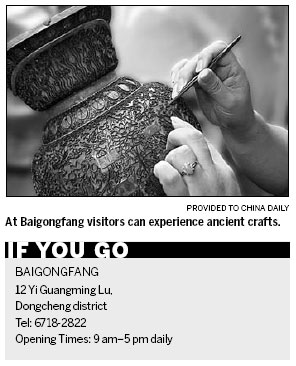- 中文
- EN
- Français
- 日本語
- 한국어
- 繁體中文
Treasure Trove of Culture Finds

Just about a kilometer east of the Temple of Heaven, there is a special museum famous not only for its collection, but more for the people working in it.
This is Baigongfang, where workshops of more than 30 traditional Chinese craftsmen are housed. They contribute their masterpieces to the museum, communicate with visitors about their skills, and pass down their expertise to apprentices.
The museum, with three levels, is nothing special seen from the outside. But as you move closer, you will soon be attracted to its layout amid Beijing's hutongs and courtyard houses.
Even if you have no knowledge about traditional Chinese handicrafts, your excitement will rise when you come face to face with crystal-like, translucent jade sculptures, stately and luxurious pieces of cloisonn ware and lifelike clay figurines with the most minute details.
The crafts the artisans show at Baigongfang can be categorized into two: One is palace art, symbolized by lacquer and ivory carving, while the other is folkcraft such as paper-cutting.
Lacquer carving has a history that dates back more than 4,000 years to the Xia Dynasty (c.21st century-16th century BC), with the palace lacquer carving from Beijing the most unique. Unlike carving on wood and then applying lacquer, craftsmen in Beijing would first coat the wood with lacquer, usually applying dozens or even hundreds of coats to build a lacquered base that is between 15 to 25 millimeters thick. Then the carving is done on the lacquer directly, rather than on the wood.
At Baigongfang, you can also experience the whole process yourself by trying your hand at the craft in a studio. One of the first studios in the line-up is Ji Shun's gourd studio, where bottle gourds are decorated with heated tools in a technique known as pyrography.
It is an easy craft for beginners to pick up, and Ji says he is more than happy to guide those who are interested in making their own gourd decorations.
There is an interesting legend that goes with the art. It was an accidental discovery back in Qin Dynasty (221- 206 BC). Gourds that were being sent as tribute to the emperor were affected by mildew in the rainy season and artists came up with the idea of burning patterns on the gourds to hide the mold in order to avoid punishment.
Baigongfang organizes do-it-yourself sessions for expatriates, and group reservations can be made in advance for creating dough figurines, clay models, paper-cuts and Chinese knots. Each session lasts about 90 minutes.
The museum runs both studios and shops, and admission is free. If you are short of time, just pick up a gift from the studios where it has been made. You won't have to worry about its authenticity.
Or, spend some time just chatting with the craftsmen here and enjoy interesting stories behind each craft, some of which have been documented since the Spring and Autumn Period (770 - 476 BC).



